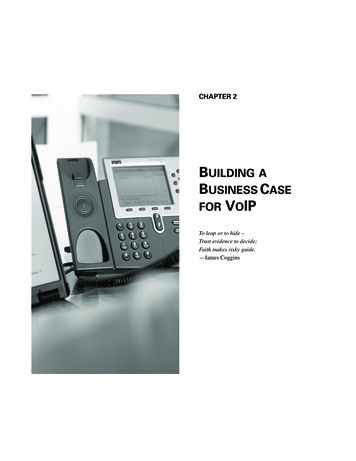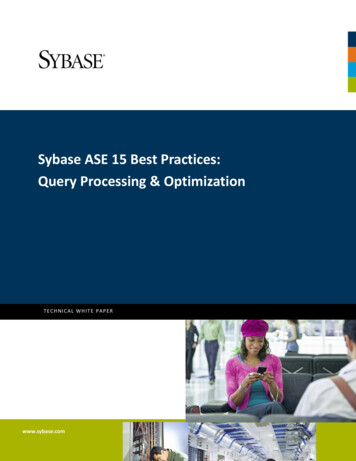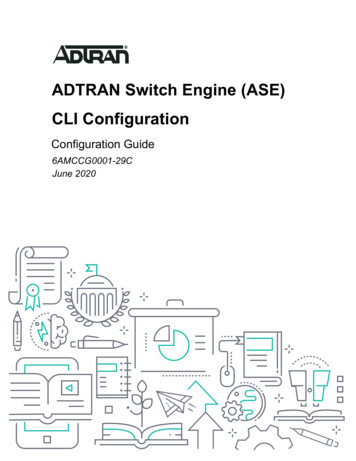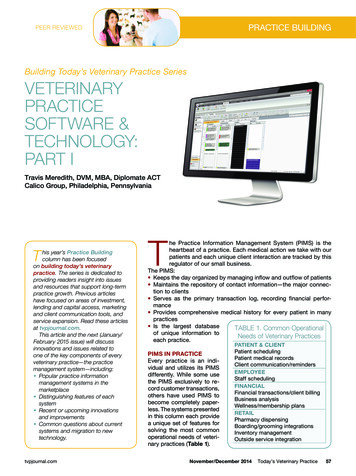
Transcription
0929FMi.book Page 29 Friday, January 30, 2004 10:34 AMCHAPTER 2BUILDING ABUSINESS CASEFOR VOIPTo leap or to hide –Trust evidence to decide;Faith makes risky guide.—James Coggins
0929FMi.book Page 30 Friday, January 30, 2004 10:34 AMTaking Charge of Your VoIP ProjectThis chapter explains how to build a business case for VoIP. It points out someof the benefits that VoIP can provide and discusses how to analyze return oninvestment (ROI) for VoIP implementation and management.A VoIP Business CaseA business case for investing in a VoIP implementation requires evaluation ofthe associated ROI. VoIP offers many potential benefits, including reduced costs,new features, and converged networks. However, some of these benefits may bemore hype than reality.Planning is important for a successful VoIP implementation. The planninginvolves evaluating the costs and benefits associated with the implementation andanticipating possible pitfalls. Understanding the most appropriate insertion pointsfor VoIP within an organization also plays a critical role in how significant the ROIcan be. The most important questions to think about during your planning includethe following: What kind of return should you expect from an investment in VoIP? What are the key factors to consider when analyzing VoIP ROI? What deployment scenarios (greenfield, Centrex replacement, and so on)are most likely to provide a positive ROI? Because management of VoIP components—networks, servers, andphones—is critical to your VoIP investment, what ongoing managementresources are necessary to ensure continued success after initialdeployment?The VoIP industry has matured rapidly. The technology has advanced in lessthan a decade from small pilot projects and test environments to large-scaledeployments in many enterprises. As new technology is adopted, it goes througha predictable process, described by Geoffrey A. Moore in his book Crossing theChasm1 and shown in Figure 2-1. There is an initial period where pioneers tend toignore ROI because they want to deploy the technology, which gives them a realor perceived technological advantage. For example, Cisco was an innovator and(30)
0929FMi.book Page 31 Friday, January 30, 2004 10:34 AMChapter 2: Building a Business Case for VoIPearly adopter of the VoIP technology that it produced. Inside Cisco, all employeeshave IP phones on their desks for everyday use. ! ! "" # %& ' " ) ' Figure 2-1 Technology Adoption Process, from Moore’s Book Crossing theChasmVoIP appears to have “crossed the chasm,” moving past the Early Adoptersphase and into the Early Majority phase. The question of VoIP adoption has shiftedfrom if to when. A 2001 study found that “90% of enterprises with multiplelocations will start switching to IP systems for voice over the next 5 years.”2 EarlyMajority users are more cautious about expending capital on still-evolvingtechnologies. They therefore prefer to wait until a technological innovation has apositive track record. In the Early Majority and all later phases of a newtechnology, it is difficult to ignore ROI and important to build a business casebefore making a purchase.The benefits of VoIP can be measured in different ways. Bottom-line costsavings are fairly easy to quantify. Other VoIP benefits, such as productivityimprovements, are more difficult to quantify in terms of ROI. These types ofbenefits sometimes require a leap of faith or intuition about potential results. Thenext section examines the potential benefits of VoIP in more detail.(31)
0929FMi.book Page 32 Friday, January 30, 2004 10:34 AMTaking Charge of Your VoIP ProjectVoIP Benefits and ObstaclesVoIP enthusiasts promise many benefits over the traditional PSTN. A greatdeal of industry excitement has been generated about the potential cost savings,the new calling features, and the reduced infrastructure of converged networks ina VoIP implementation.There are two main types of benefits to VoIP—hard benefits and soft benefits.Hard benefits come with a clearly-defined cost savings. For example, replacing aPBX with a VoIP server may save a company a specific amount of money everyyear. On the other hand, soft benefits don’t necessarily save money, or, if they do,they don’t always save an easily calculated amount of money. But they have thepotential to affect the bottom line in the future if, for example, your decision toinnovate with unified messaging today means that your company is ready to makeanother technological leap in the future. Although both types of benefits arecritical to the final ROI, most organizations focus more on the hard cost savings,because they are easier to quantify. Oftentimes it is appropriate to clearlydifferentiate between hard and soft benefits to improve the credibility of thebusiness case with financial decision makers. The next section takes a closer lookat three broad categories of VoIP benefits: cost savings, new features, andconvergence.Cost SavingsExpenses are almost always a driving factor in IT spending decisions. You oryour boss has probably asked, “How can we do business more efficiently, withlower costs?” Cost is no less a factor if you are looking at a VoIP implementation.The cost of VoIP can be intimidating, with the need for plenty of new equipment(remember the components discussed in the introductory chapter?) and possibleinfrastructure upgrades. A large initial capital outlay can be cost prohibitive forsome organizations.However, these likely costs should not scare you away. Many companies arenow offering equipment-leasing plans to reduce the initial capital outlay and letyou spread the expense over several years. It is also a good idea to stage thedeployment gradually as a means of easing the costs. Each organization generally(32)
0929FMi.book Page 33 Friday, January 30, 2004 10:34 AMChapter 2: Building a Business Case for VoIPhas a variety of sites. These sites could be small branches, regional offices, orglobal headquarters. They could be new facilities or existing facilities that requirea replacement for their current PBX. The ROI for VoIP is often different acrossthese different site types and deployment scenarios. Many successful VoIPimplementations recognize these differences and use them to guide their insertionstrategy for VoIP.The best approach to a VoIP implementation is to view it as an investment; itis intended to provide returns in capital and productivity savings. The cost savingsfrom VoIP are likely to occur in several areas. Figure 2-2 shows a good estimateof where you can expect to gain the savings.Network Carrier Costs22%Equipment and Maintenance34%44%Network AdministrationFigure 2-2 Contribution to VoIP Cost SavingsFrom “The Strategic and Financial Justifications for Convergence,” Cisco Systems white paper, June1, 2001 iptl/cnvrg wp.htm).The following sections consider these cost savings as they apply to capital,expenses, and productivity.Capital and Expense SavingsWhen VoIP technology first appeared, a major enticement was “free phonecalls.” It has been said that there is no such thing as a “free lunch,” but is thereindeed a “free VoIP phone call?” Sort of. In the PSTN, the network is owned bythe telephone provider. When you make a call, you are billed for the usage of thisnetwork. Long-distance costs can vary depending on the distance called (locationof caller and callee) and the time at which the call occurs. And long-distancetelephone calls can be a major line item in an organization’s budget. In a VoIP(33)
0929FMi.book Page 34 Friday, January 30, 2004 10:34 AMTaking Charge of Your VoIP Projectimplementation, the network is an IP network, and calling distance does notmatter. If you own the IP network or are already paying an Internet serviceprovider (ISP) for bandwidth, then VoIP employs an infrastructure that is alreadypaid for, so VoIP calls could be considered free.Long-Distance Service SavingsLong-distance rates on the PSTN have decreased dramatically over the sameyears that VoIP has matured. Assessing the cost of long-distance service iscomplicated because different rate structures apply to different types of calls. Ifyou call inside your local area, one rate may apply, whereas another rate mayapply to calls beyond this area. Yet a third rate may apply to calls that crossnational boundaries. Throw in the myriad wireless calling plans with free longdistance, and the cost savings from VoIP may be difficult to gauge.Consider interoffice calls. Nowadays, large corporations typically findthemselves with offices or supply chains spread out over many geographicallocations, in countries all over the world. What is the cost of telephonecommunications with these offices and suppliers? To calculate this cost, you needto know how many telephone lines or how much call bandwidth you have goingin and out of each office, and your typical long-distance bill. Depending on theconfiguration of your network and the locations of the calls you need to make,your long-distance tolls could plummet after implementing VoIP. After all, thereis no distinction to be made on a data network between an international link and aregional link.Bypassing the PSTN and making telephone calls on an IP network is referredto as toll bypass. Toll bypass occurs when a PBX or an IP PBX is connected to aVoIP gateway, which is then connected to an IP network, as illustrated in Figure2-3. The call traffic goes from the PBX to the VoIP gateway instead of from thePBX to a PSTN switch, thus avoiding the toll, or cost of using the PSTN. As aresult of the PSTN toll rate structure, companies with a large number of(34)
0929FMi.book Page 35 Friday, January 30, 2004 10:34 AMChapter 2: Building a Business Case for VoIPinternational sites are likely to see more cost savings from toll bypass thancompanies that make most of their calls within the United States.* ! ! # # # '* ! ! !" ! !" ! ( !, # % &' (' ) ! ) !% &' (' # Figure 2-3 Toll BypassSavings may not be immediate or automatic, however. Many organizationsshould not convert to VoIP completely, or all at once. The PSTN lines may still beneeded for some time during the migration phase, and some companies may wantto keep the PSTN as a fallback network. But, in most cases, the long-distance costsassociated with PSTN usage should decrease after a VoIP implementation.Single Network Infrastructure SavingsThe popular acronym KISS—Keep It Simple, Stupid—applies to your ITstrategy. Maintaining separate network infrastructures is neither simple nor cheap.VoIP offers a single network infrastructure built on an IP network. How does thisresult in savings? A single network can lower the cost of network ownership. Instead ofbuying or leasing a PBX and network infrastructure for PSTN calls, youcan spend the money on IP network infrastructure. Both voice and datatraffic can take advantage of the enhancements. These savings allow VoIPto provide a lower total cost of network ownership.(35)
0929FMi.book Page 36 Friday, January 30, 2004 10:34 AMTaking Charge of Your VoIP Project Similarly, VoIP can provide a reduced incremental cost of networkownership. For example, what is the current per-user cost for phoneservice? How does adding a new user affect this cost? Adding anadditional user to a traditional PBX system may require upgrading to anew PBX with greater capacity, thus increasing the per-user cost of thesystem. By contrast, most campus LANs have nearly unlimited capacity,allowing a new VoIP user to be added at a reduced per-user cost.Incremental costs also extend to the addition of new corporate offices,which can often be easily and cheaply added to a VoIP-enabled datanetwork. A single network is easier to expand and change. Consider this scenario:You have 10 T1 links for your PSTN traffic (supporting up to 240 calls)and a DS3 link for your data traffic. (As mentioned in Chapter 1, a DS0link, with 64-kbps capacity, is a standard building block of the PSTN. ADS3 link has a 44.736 Mbps capacity.) The T1 links are operating atmaximum capacity, but your DS3 link has plenty of bandwidth available.Your organization is growing. Instead of purchasing another T1 link for theincreased call volume, moving to a VoIP implementation would let you usethe available capacity on the DS3 link to carry additional voice traffic. A single network offers reduced wiring costs, especially in newconstruction. Instead of wiring for both data and voice, you pull one setof wiring. Wiring for both voice and data can be accomplished in manydifferent ways, so proceed carefully. For example, you never want yourIP phone and computer to share a hub; if you run a database query whileyou are on the phone, you could get reduced call quality. Such trade-offs arediscussed in more detail in Chapter 5, “Quality of Service and Tuning.” A single network can easily incorporate wireless infrastructures. Wiringa home or office for a data network can be expensive, so manyorganizations are turning to wireless networks using 802.11 technology.These wireless LANs support IP network applications readily, makingVoIP easy to implement in this type of environment, but there are tradeoffs with regard to security and potential performance issues.(36)
0929FMi.book Page 37 Friday, January 30, 2004 10:34 AMChapter 2: Building a Business Case for VoIP Several VoIP manufacturers offer centralized call-processingarchitectures. Centralized call processing enables an organization toconsolidate its core call-processing equipment in one or several sites andthen extend voice services to each site within the organization. For manyfirms, this enables them to remove PBX and key systems from each sitewith the enterprise while providing similar and oftentimes superiorfeatures and functionality to the branch sites. Centralized call processingis a compelling method to reduce equipment, maintenance, and supportcosts. It also enables many organizations to standardize the voiceservices that they deliver to their employees. Instead of requiring internalor outsourced resources to manage each PBX or key system, acentralized team can now manage the entire organization’s voice servicesfrom a single site.Productivity SavingsAnother set of quantifiable benefits in a VoIP implementation involvessavings due to productivity improvements in your IT operations. When you arethinking about moving to VoIP, be sure to consider what the new demands willmean to your IT staff, who may already be overloaded. At first glance, it may seemto be a paradox—that rolling out VoIP could offer IT savings, both for capital andstaff. However, a VoIP implementation can bring IT staff savings in several areas,as discussed in detail in the following list: Management and support savings—For a traditional PBX phonesystem, you need one staff to manage the telephony system and anotherstaff to manage the data network. With a VoIP system, these jobs usuallymerge. The convergence of infrastructure may make it feasible to reducethe internal staff required for support and management of the twoseparate infrastructures. However, these savings may come with a highinitial cost for training. Managing a converged network requires aconsolidation of skills. VoIP thus requires significant training for thedata-networking group learning telecom skills, or for the telephonygroup learning data-networking skills. One way to try to estimate thetraining costs associated with VoIP is to compare a VoIP deployment tothe rollout of other business-critical technologies. For example, the move(37)
0929FMi.book Page 38 Friday, January 30, 2004 10:34 AMTaking Charge of Your VoIP Projectfrom office memos and “snail mail” to an e-mail system was quite a leaptechnologically and required extensive training to deploy and manage. AVoIP deployment has similar characteristics. Maintenance, upgrades, and additions—Each time a new user ismoved, changed, or added to the voice network, an organization incurs acost. This cost can be as high as 150 per move, add, or change. In oneestimate, these actions accounted for as much as 14 percent of an ITbudget. VoIP uses IP protocols such as Dynamic Host Control Protocol(DHCP) to allow IP phones to automatically reconfigure themselveswhen moved from one location to another. Employees can move theirown phones, potentially saving thousands of dollars per year. In addition,adding and changing phones become simpler, because they can often beaccomplished via a software application instead of a visit by a technician.An interesting development driven by the enhanced mobility of VoIP isthat many organizations are now able to move their employees morefrequently to better align them with the changing dynamics of thebusiness. Enhanced mobility—Some vendors of VoIP offer number portability.This lets individuals log in to any phone within the organization and stillhave their extension number (and any applications or services they use)available to them even though they are away from their desk. Thisenhanced mobility lets many organizations institute more flexible workenvironments that allow them to reduce facilities and real estate costs,while increasing employee productivity and morale. Reduced site preparation time—The need to string only one set ofwires has also allowed many organizations to reduce the time it takes forthem to set up new sites. In certain industries, this new capability isdriving significant cost savings and even revenue growth.When analyzing the cost savings that a VoIP implementation can provide,consider this important reality: Because end users don’t see cost savings directly,they are less tolerant of reduced quality or reduced reliability. Employees in yoursales department may not care that the company is saving two cents per minute onVoIP calls if their sales productivity is decreasing because of poor-quality calls ordropped calls.(38)
0929FMi.book Page 39 Friday, January 30, 2004 10:34 AMChapter 2: Building a Business Case for VoIPNew FeaturesNew applications and features offer productivity improvements for both endusers and IT staff. The benefits offered by new applications and features are noteasily quantifiable, but arguably offer some of the most compelling reasons toconsider a VoIP implementation.VoIP technology vendors have been looking for the killer applications to drivethe enablement and deployment of their products. Do new features imply newrevenue for businesses that deploy VoIP? It is possible. Consider the following:VoIP allows for easier integration of voice with other applications. For example,web commerce applications offer voice as a means of helping customers placeorders or talk to a customer service agent. Consider pithy business statistics likethese: “A 5% improvement in customer loyalty can improve profitability by 40 to95%”3and “Cutting customer defections by just 5% has the effect of boostingprofits between 25% and 95%.”5Here are several examples of new applications and features that VoIP can enable: Unified messaging—This widely anticipated VoIP application is startingto pay dividends. Now that many vendors are offering voice mail, e-mail,and fax integration, users are beginning to take advantage of unifiedmessaging systems. The ability to retrieve your messages anytime,anywhere, and in any way makes unified messaging systems anappealing productivity booster. A 2001 study found that unifiedmessaging can provide 25 to 40 minutes of added employee productivityeach day.4 Productivity improvements come as employees reduce thetime they spend retrieving messages and faxes from the home office, aswell as the sometimes-lengthy search for an Internet connection to checke-mail while on the road. With expanded options for working from home,employees who once had to face a tough choice when they needed to care fora sick child can now complete more of their work
Chapter 2: Building a Business Case for VoIP (31) early adopter of the VoIP technology that it produced. Inside Cisco, all employees have IP phones on their desks for everyday use. Figure 2-1 Tec hnology Adoption Process, from Moore’s Book Crossing the Chasm VoIP appears to











